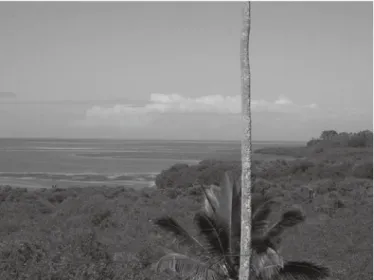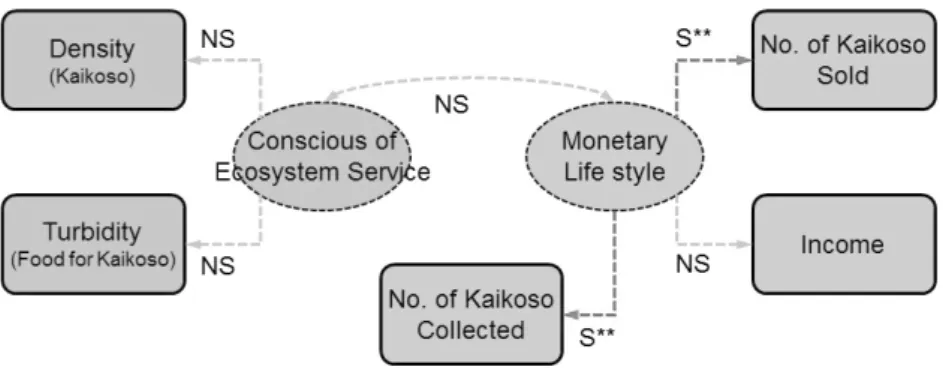Ecology-Economy Interacting System in Marine
Resources in Fiji
著者
KAWAI Kei, KOBARI Toru, TORII Takashi,
NISHIMURA Satoru
journal or
publication title
南太平洋海域調査研究報告=Occasional papers
volume
54
page range
47-52
URL
http://hdl.handle.net/10232/24738
Integrated-Disciplinary Evaluation of Ecology-Economy
Interacting System in Marine Resources in Fiji
KAWAIKei1, KOBARIToru2, TORIITakashi2 and NISHIMURASatoru3
1: Research Center for the Pacific Islands, Kagoshima University 2: Faculty of Fisheries, Kagoshima University
3: Faculty of Low, Economics and Humanity, Kagoshima University
Abstract
Republic of the Fiji Islands (Fiji) is one of the Melanesian countries. There are social systems dependent on the nature that is highly productive for fishery resources in mangrove-coral ecosystems. Such beautiful natures and specific cultures are tourist resources for not only Fiji but also the other islands, but the tourism has been resulted in various problems. Thus, it is a challenge to make a good living for island people with “symbiosis” between the natures and human activities. In the present study, we evaluate the relationships of ecological and social systems on fishery resources in a Fijian local village from the viewpoint of natural and social sciences (integrate-disciplinary study).
In the objective village, there was a life style dependent on farming and fishing. The number of people in a family was less than those in the neighboring village because young people were working in urban areas or overseas to send living expenses to the village people. A major fishery resource was a bivalve “kaikoso” which was collected and sold by women and important seafood and income for the village people. Kaikoso inhabited at the coastal sites between mangrove and coral reef and was more abundant than the other islands.
In this paper, we will show a simple model which factors have most affected the fishery resource and also we introduce a significance to study the lure of islands from the viewpoint of “integrate-disciplines”.
Keywords: bivalves, ecology, economy, Fiji, integrate-disciplinary
Introduction
The Republic of the Fiji Islands (Fiji) is one of the Melanesian countries. Fiji’s social systems depend on a natural environment that has highly productive fishery resources in mangrove-coral ecosystems. This beautiful natural environment and Fiji’s many different cultures are tourist attractions, not only for Fiji, but also for other islands in the region. Tourism, however, has resulted in various problems. Thus, it is a challenge for island people to make a good living while depending on the co-existence of nature and human activities. In
the present study, we evaluate the influences of ecological and social systems on fishery resources in a local Fijian village, from the interdisciplinary viewpoint of the natural and social sciences.
Natural environments and their resources are vital to human existence. Human activities in many localities have led to environmental pollution and decreased biodiversity, and this phenomenon has become global in scale. Understanding the relationship between humankind and the nature from a global perspective is crucial.
In a traditional village, the lifestyle was dependent on farming and fishing. A bivalve called “kaikoso,” which was major fishery resources, was collected and sold by women, and provided important seafood and income for the village people. Kaikoso inhabited coastal sites between mangroves and coral reefs, and is more abundant here than in the other islands.
The relationship between the nature and human activities encompasses a complicated system affected by many factors. Therefore, the study of such systems requires an interdisciplinary perspective (e.g., REPKO 2012). For example, coastal marine resource
management is related to a wide array of academic fields, including sociology, economics, and ecology. Consequently, it is preferable to study this topic from both ecological and socio-economical perspectives, as advocated by interdisciplinary research.
Interdisciplinary Study
The primary component of the present study’s research method is the integrated- disciplinary evaluation of ecology and economics. A complicated ecosystem comprising tidal flats, mangrove forests, and coral reefs is important to both the islands’ environment and its society (Fig. 1), due to its high biodiversity and its residents’ reliance on marine resources for consumption and commercial purposes.
Ecologists and economists participated in our research group, and although group members focused on their own respective fields, collective meetings were held monthly. Also, because field research occurred concurrently in the same village, a shared experience and understanding of kaikoso existed, which was further enhanced through frequent discussions. Since group members shared their data, experiences, and thoughts, it was possible to comprehensively understand other academic specializations and to conduct an interdisciplinary evaluation. Finally, group members proposed a conceptual model of the interactions between ecological and economic systems and their relationships with the marine resources, and assessed this model using a statistical method, namely, Structural Equation Modeling (SEM) (BOWEN and GUO 2011).
Fig. 1. The coastal area, coexisting mangrove forest, tidal flat, and coral reef on the Viti Lavu Island in Fiji.
Study Site
The study village—Viti Lebu—is located on the eastern side of the main island of Fiji. Although the mangrove forests are not rich, they grow in the island’s coastal areas; coral reefs are present in the offshore areas (KAWAIet al. 2008, MANABEet al. 2008).
The village’s lifestyle is dependent on farming and fishing (NISHIMURA 2006). The
number of members in each household is less than the number of household members in the neighboring village. This is so because many youths are employed in the tourism industry, and live either in urban areas or overseas, and regularly send money home to sustain their relatives in the village. Kaikoso is a major fishery resource. It is collected by the women and sold to earn an income. Kaikoso is a bivalve, and feeds on organic matter in the seawater; it inhabits the coastal sites between mangroves and coral reefs, and is more abundant in Viti Lebu than on other islands.
Objectives
This paper will begin by demonstrating the ecological importance of kaikoso to mangrove-tidal flat ecosystems, and the island’s economic and social systems. Then, a Fijian village’s kaikoso resource management practices will be evaluated from a natural and social science viewpoint. The model is simple, and considers which factors have most affected this fishery resource, while also explaining the significance of studying the location from an interdisciplinary perspective.
The Impact of Kaikoso Feeding on Nature
An experiment was conducted to determine the importance of kaikoso feeding activities on the mangrove-tidal flat ecosystem. Four aquarium tanks were prepared and filled with seawater, with one pair of tanks containing kaikoso and the other none. The dry weight of the suspended particles and plankton biomass (i.e., food organisms for kaikoso) were compared between both pairs of tanks. In natural seawater, suspended particles and plankton increased without the kaikoso; however, in the presence of filter-feeding kaikoso, the opposite occurred. This result is in agreement with BUHADIet al. (2013), who suggested that kaikoso feeding
plays an important role in the removal of tidal flat particles supplied by the mangrove.
Kaikoso is usually found near sandy shallow areas of tidal flats that are easily accessible
from the shore by foot. The average density of kaikoso varies between 13 and 15 each/m2 (unpublished data). However, the density of a bivalve of the same genus in Kiribati is approximately 5 each/m2. This suggests that even under the impact of an intense fishery, the densities reported in Fiji are higher than those in other Pacific Islands. Furthermore, the results indicate that kaikoso plays a very important role in the research location’s coastal ecosystem.
The Economy: A Case for Women Collecting Kaikoso
A household survey was conducted to investigate the kaikoso fishing habits of women in the village. The sample included 15 women who regularly collect kaikoso. The average number of households surveyed was 4.3 ± 0.38 (mean ± SE), with an average income per week of 116.7 ± 28.03 F$ (mean ± SE) (unpublished data).
The daily catch of kaikoso varied between 2 to 5 heaps, while the women’s weekly catches were between 5 to 15 heaps, with an average of 11 (unpublished data). Each heap includes approximately 65 individual kaikoso. Because each heap is worth 2 F$ at the Suva Market, the weekly income generated from the kaikoso is 22 F$, or approximately 20% (22 F$/117 F$) of the total weekly income. These results indicate that kaikoso is a very important source of income for the community.
Structural Equation Modeling: Natural-Social System Concept
A model depicting the relationship between the ecological and economic factors of
kaikoso fishing activities was developed. The natural and social parameters were collected in
Fig. 2 (unpublished data). Ovals indicate concepts describing natural-social systems. The KAWAI Kei, KOBARI Toru, TORII Takashi and NISHIMURA Satoru
model’s hypothesis is that Fijian people have a “consciousness of the ecosystem’s service” and a “monetary lifestyle,” both of which affect the environmental conditions of kaikoso and the villagers.
Modeling Results
There were no significant interactions between villagers’ consciousness of the ecosystem’s services and monetary lifestyles. However, villagers’ consciousness of monetary lifestyles significantly affected the number of kaikoso sold and collected. This means that when a small amount of money is needed, the villagers collect kaikoso to sell at markets, which subsequently indicates that sustainable resource use exists in the study location.
Summary
1) The kaikoso feeding activities are of significant ecological importance to the tidal flat ecosystem
2) The kaikoso is an important source of income for women in the village
3) SEM is a powerful tool for evaluating natural-social system concept, and interdisciplinary research promotes a better understanding of the relationship between the nature and humans
Acknowledgments
The authors wish to express their thanks to Dr. Joeli VEITAYAKI for his kind help and
cooperation in conducting the fieldwork and respiratory experiments at the University of the South Pacific. A portion of this study was supported by the Japan Society for the Promotion of Science (JSPS) (21401013). This report was modified by the report of KAWAIet al. presented
at the 1st East Asian Island and Ocean Forum on 11 November, 2013, which will be published soon.
References
BOWEN, N. K. and GUO, S. 2011. Structural Equation Modeling, 240 pp., Oxford University
Press, UK.
BUHADI, A. E. S. M. Y, KOBARI, T., KAWAI, K., YAMAMOTO, T., SUZUKI, H., NISHIMURA, S.,
TORII, T. and VEITAYAKI, J. 2013. Food Availability for Particle-Feeding Bivalves,
Anadara spp. in Fiji. Pacific Science, 67(4): 539-551.
KAWAI, K., KOBARI, T., MANABE, H. and ZANN, L. 2008. Fisheries and Marine Environments
in the Coastal Area in the Island Coexisting Mangrove Forest and Coral Reef – A Case Study at the Village in Viti Levu Island, Republic of the Fiji Islands. The Journal of Island Studies, 7: 1-16 (in Japanese).
KAWAI, K. 2011. Molluscan Biodiversity in Replanted and Natural Mangrove Forest: A Study
on the Island of Viti Levu in Fiji. The Journal of Island Studies, 11: 25-34.
MANABE, H., KOBARI, T., KAWAI, K. and ZANN, L. 2008. Ichthyfauna around Coastal Area
Coexisting Mangrove Forest and Coral Reef in Viti Lavu Island, Fiji. The Journal of Island Studies, 7: 17-26.
NISHIMURA, S. 2006. Fijian State and the Traditional Society. Journal of Economic and
Society, 65: 49-66.
REPKO, A. 2012. Interdisciplinary Research: Process and Theory. 2nd ed., 544 pp., SAGE
Publications, Los Angeles, USA.

